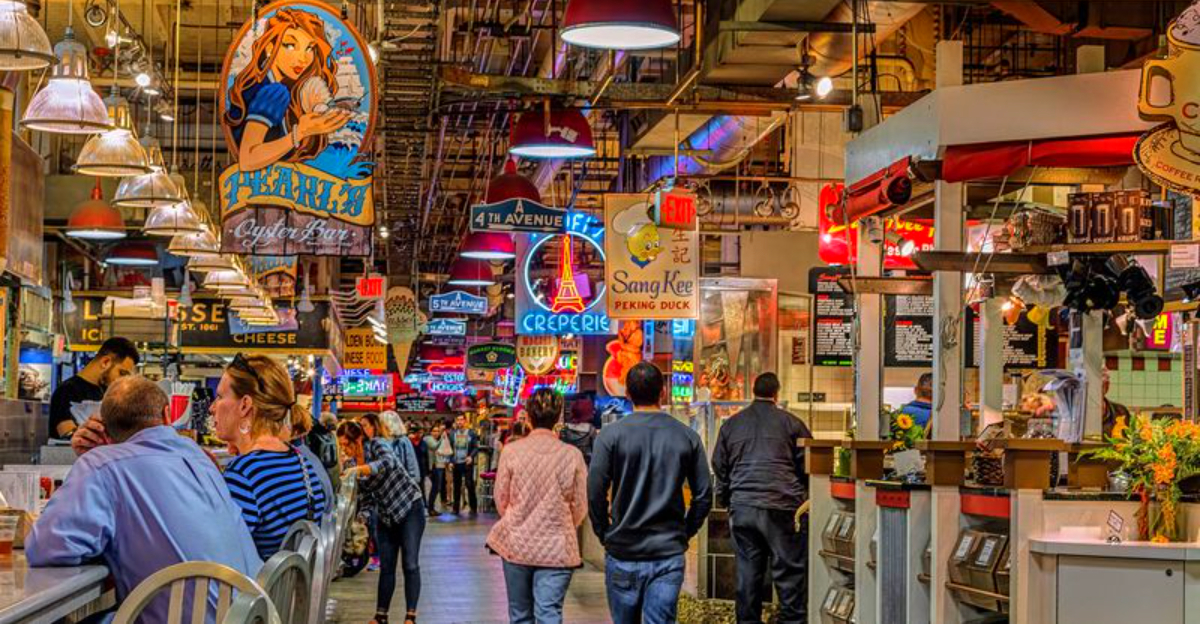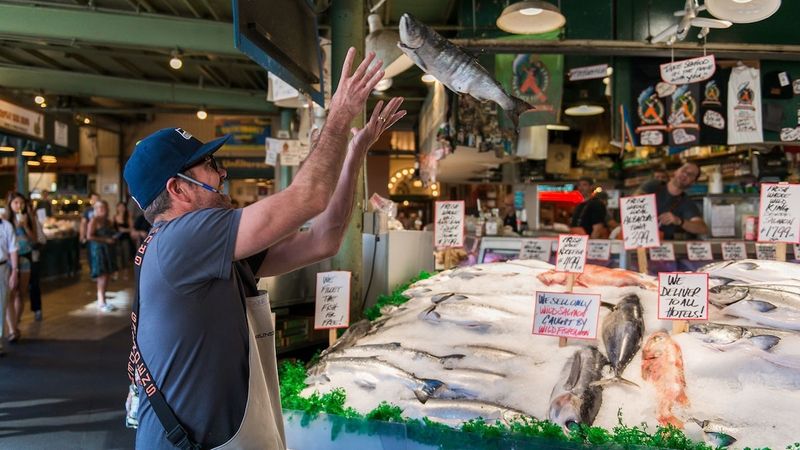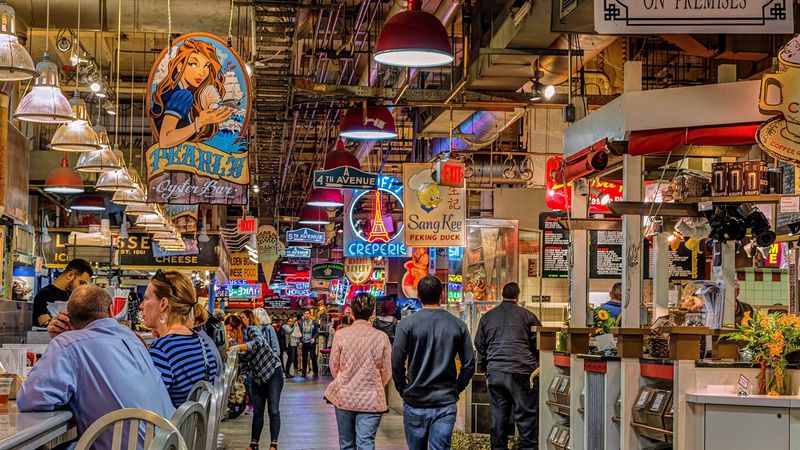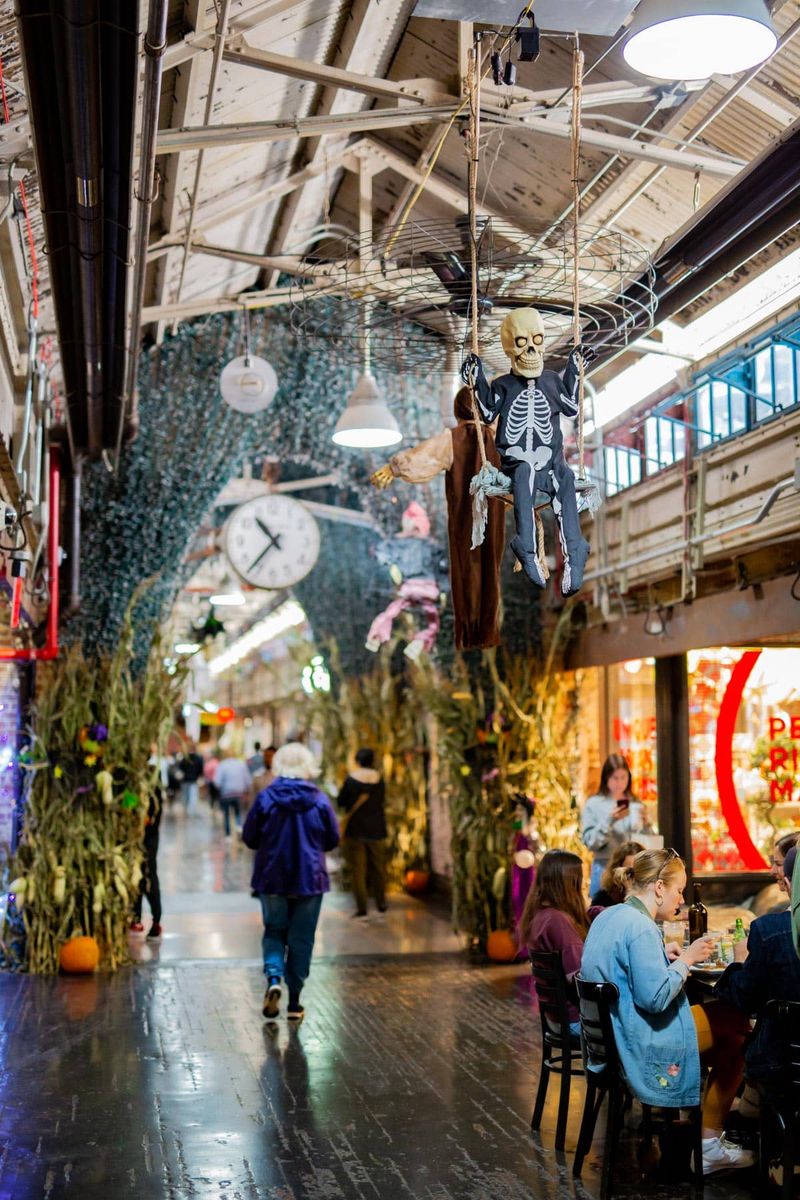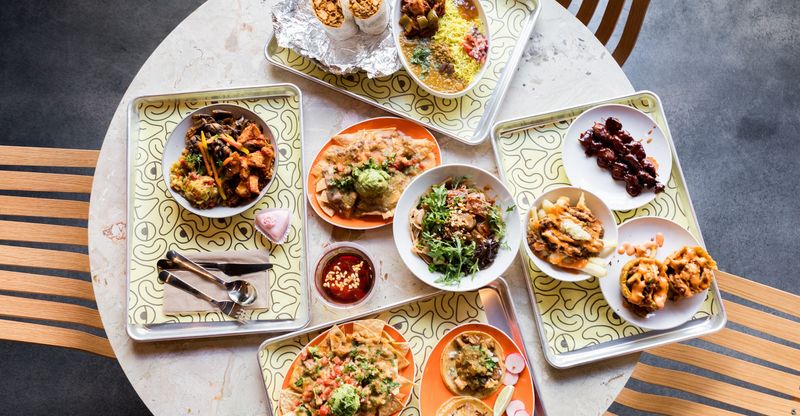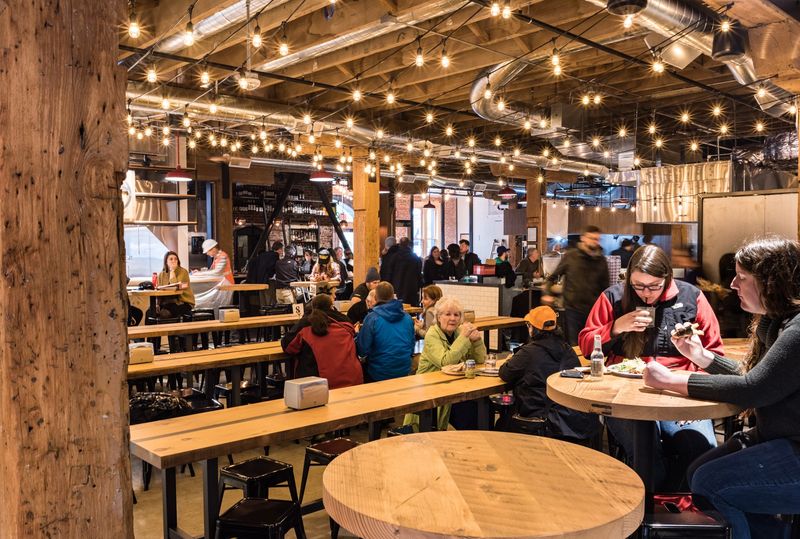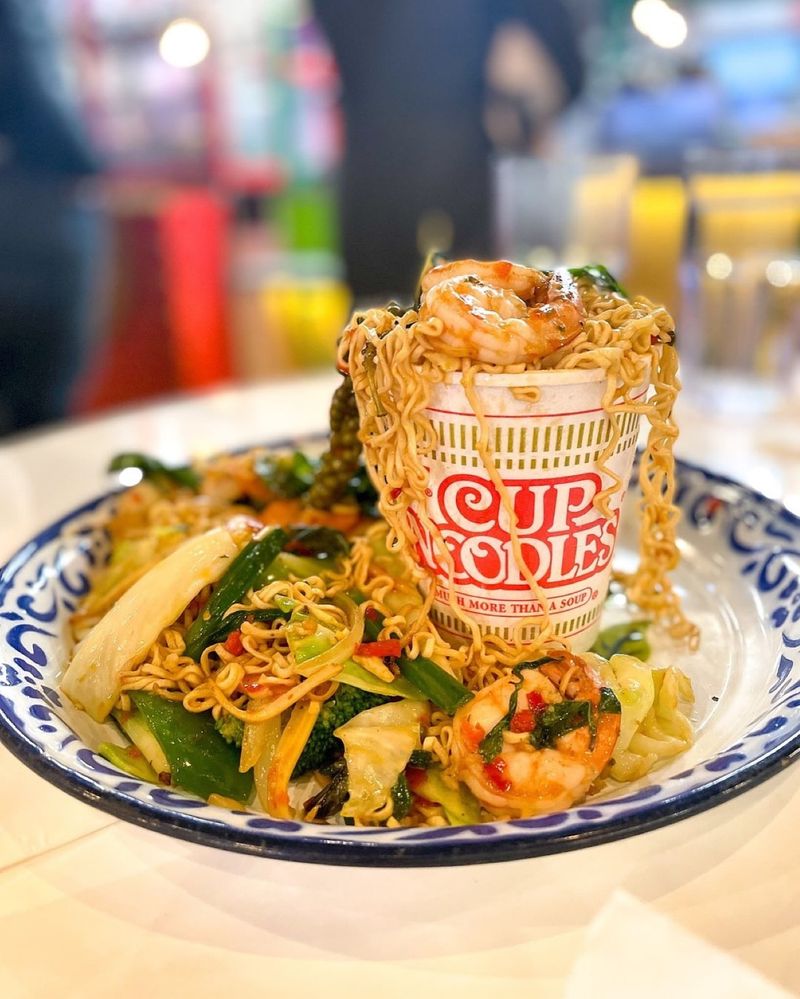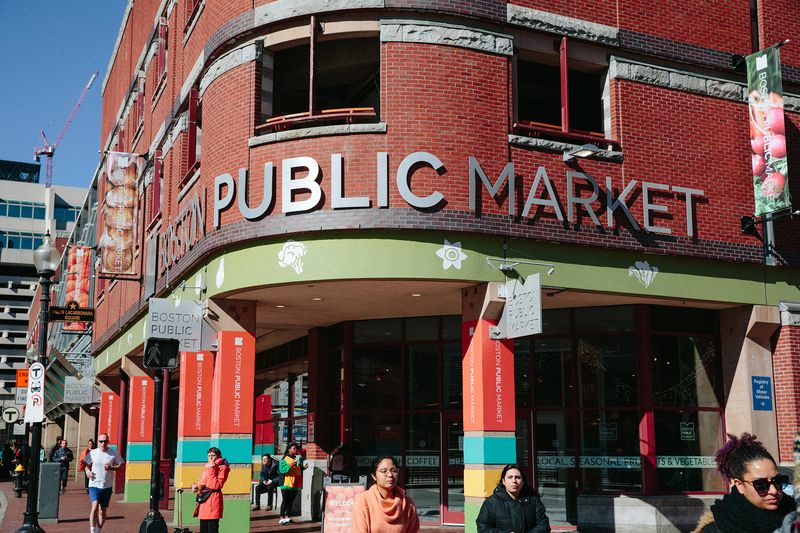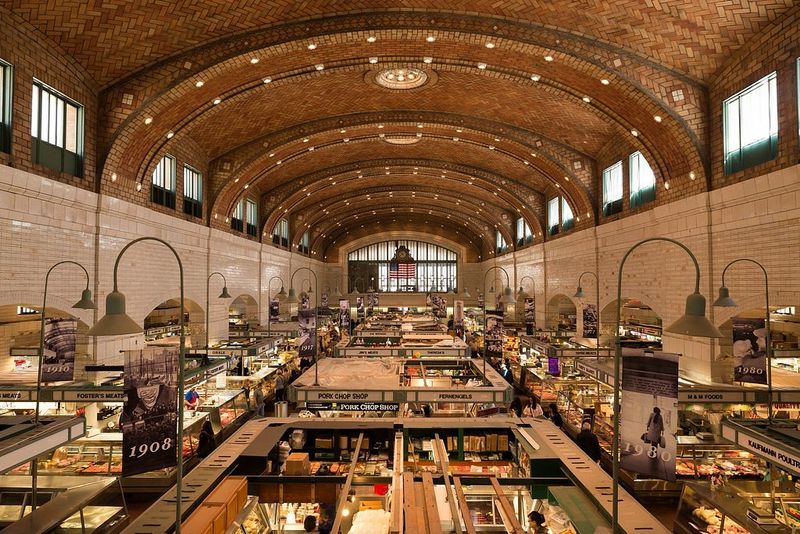Food halls have transformed the American dining scene, offering culinary adventures under one roof. These bustling marketplaces bring together local chefs, artisanal food vendors, and unique flavors that showcase regional specialties. From historic markets that have stood for generations to modern culinary hubs, these food destinations turn a simple meal into an unforgettable experience.
Pike Place Market — Seattle’s Waterfront Wonder
Salmon flies through the air as fishmongers toss fresh catches to the delight of mesmerized crowds. Operating since 1907, Pike Place isn’t just Seattle’s oldest food hall—it’s a living museum of culinary tradition.
Wandering through the labyrinth of stalls reveals artisanal cheeses, crusty sourdough loaves, and vibrant produce from local farms. The market’s lower levels hide seafood restaurants where you can taste what you just saw being tossed.
The sensory overload—fish aromas, flower fragrances, street performers’ melodies—creates an atmosphere that connects visitors to the Pacific Northwest’s bounty in ways no restaurant could replicate.
Reading Terminal Market — Philadelphia’s Historic Food Paradise
Amish vendors in traditional dress sell hand-rolled pretzels mere steps from Korean bibimbap stalls in this 130-year-old market. The mingling aromas of Pennsylvania Dutch scrapple, Middle Eastern falafel, and fresh-baked cookies create an intoxicating sensory symphony.
Located in a former railroad terminal, the market’s industrial architecture frames over 80 merchants selling everything from local meats to exotic spices. Locals crowd around counter seats at Beiler’s Donuts and DiNic’s roast pork sandwiches.
What makes this market special isn’t just the food—it’s how it preserves Philadelphia’s multicultural heritage while continuously evolving with new flavors.
Chelsea Market — Manhattan’s Industrial Chic Food Destination
Housed in the former National Biscuit Company factory where the Oreo was invented, Chelsea Market’s brick-lined passages now host culinary treasures instead of cookie production. The iron beams and exposed pipes create an atmosphere that’s simultaneously rustic and metropolitan.
Food pilgrims navigate between Los Tacos No.1’s authentic Mexican street food and Lobster Place’s fresh seafood counters. Water features and art installations punctuate the spaces between eateries, creating moments of calm amid the delicious chaos.
The market’s location in Manhattan’s Meatpacking District means you can fuel up before exploring the nearby High Line park—a perfect New York day combining industrial history with culinary innovation.
Chicago French Market — Midwestern Flair Meets European Style
Sunlight streams through the windows of the historic Ogilvie Transportation Center, illuminating a European-inspired marketplace where commuters and food enthusiasts converge. Unlike tourist-heavy destinations, this food hall captures Chicago’s authentic local rhythm.
Vendors arrange artisanal cheeses alongside freshly baked croissants, while the scent of brewing coffee mingles with spices from global cuisine stalls. The market’s clever design creates intimate dining nooks amid the openness.
Morning brings briefcase-carrying professionals grabbing breakfast; lunch sees downtown workers discussing business over Vietnamese banh mi; evenings transform the space into a relaxed dinner spot where Midwestern hospitality shines through every interaction.
Saluhall — San Francisco’s Scandinavian-Inspired Culinary Haven
Minimalist blonde wood and plants hanging from skylights create a distinctly Nordic atmosphere in this Bay Area gem. Founded by Swedish chef Roberth Sundell, Saluhall reimagines the traditional food hall through a sustainability-focused lens.
The plant-forward menu options don’t sacrifice flavor—smoked mushroom sandwiches deliver umami intensity that rivals any meat dish. Between bites, visitors can watch cooking demonstrations or sip aquavit at the sauna-themed bar, complete with cedar-scented air.
What makes Saluhall special is its thoughtful curation—each vendor complements rather than competes with others, creating a cohesive experience rather than the food court chaos found elsewhere.
Pine Street Market — Portland’s Culinary Laboratory
Housed in a restored 1886 building in Portland’s Old Town, this food hall embodies the city’s reputation for culinary innovation and sustainable practices. The original wooden beams frame modern food stalls where established chefs experiment with new concepts.
Olympia Provisions’ famous charcuterie sits alongside Marukin Ramen’s steaming bowls and Salt & Straw’s whimsical ice cream creations. The communal seating encourages conversation between strangers—a rarity in modern dining.
Portland’s famous quirkiness comes through in unexpected touches: Korean fried chicken served with locally foraged mushrooms, or cocktails garnished with edible flowers grown just blocks away. Every bite tells a story about Oregon’s agricultural bounty.
Asean Streat Food Hall — Seattle’s Southeast Asian Escape
Step through the doors and suddenly you’re transported from rainy Seattle to a vibrant Southeast Asian night market. Lanterns glow overhead while the sizzle of woks and fragrance of lemongrass create an immersive sensory experience.
Ten specialized stalls represent different ASEAN countries—from Cambodian fish amok to Indonesian rendang and Filipino lumpia. The vendors, many first-generation immigrants, cook family recipes passed down through generations.
What makes this relatively new addition to Seattle’s food scene special is its authenticity. Rather than Americanized versions of Asian dishes, Asean Streat celebrates regional specialties in their traditional form, encouraging cultural exploration through food.
Boston Public Market — New England’s Seasonal Showcase
Morning light floods through tall windows illuminating pyramids of just-picked apples and piles of freshly dug potatoes at this year-round indoor market. Unlike conventional food halls, Boston Public Market operates with a unique rule: everything sold must be produced or originate in New England.
Fourth-generation fishmongers arrange the morning’s catch beside farmers who’ve driven pre-dawn from Vermont and Maine. The market functions as both grocery and dining destination, with prepared food vendors transforming local ingredients into memorable meals.
Seasonal shifts dramatically change what’s available—spring brings fiddlehead ferns and ramps; summer showcases heirloom tomatoes; fall offers cranberry harvests; winter highlights root vegetables and preserved goods.
West Side Market — Cleveland’s Century-Old Culinary Cathedral
Sunlight streams through stained glass windows onto a mosaic floor where generations of Clevelanders have shopped since 1912. The soaring clock tower visible throughout the neighborhood announces this isn’t just a market—it’s a Cleveland institution.
Over 100 vendors operate from stalls featuring remarkable cultural diversity: Polish pierogi makers beside Lebanese hummus specialists, Hungarian sausage crafters next to Italian pastry artisans. The market’s architecture—with its Guastavino tile ceiling—rivals European food halls in grandeur.
Families pass down vendor stalls through generations, creating a living museum of Cleveland’s immigrant history. Regulars know to arrive early for the best selection and to bring cash—some traditions never change.
The Spot — Rockville’s Modern Asian Food Collective
Neon signs glow against sleek black surfaces in this contemporary food hall dedicated to pan-Asian cuisine. Unlike traditional markets, The Spot embraces modern aesthetics while delivering authentic flavors from across East and Southeast Asia.
Teenagers sip boba tea while grandparents enjoy familiar comfort foods from their homelands—a testament to The Spot’s cross-generational appeal. The specialized focus allows for greater depth of offerings: five different regional Chinese cuisines, Korean street food, Japanese ramen, and Taiwanese specialties all under one roof.
Weekend dim sum draws crowds from across Maryland and Virginia, transforming the space into a community gathering place where food traditions are both preserved and reimagined for new generations.
